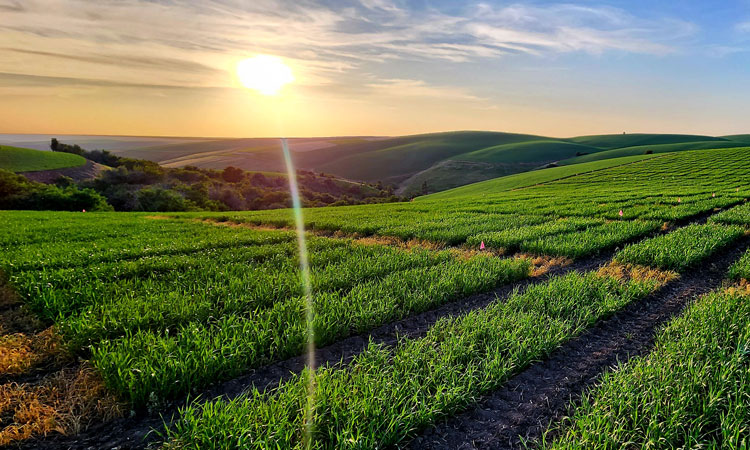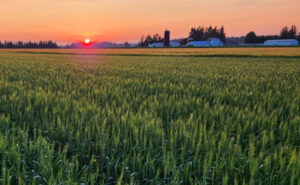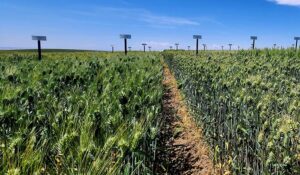Pest and weed control, soil degradation, climate, quality all on research radar
Production technology, grain markets, consumer preferences, growing conditions, pests, diseases, weeds, and economic realities continue to evolve. As the “staff of life,” wheat production with improved varieties must do the same. Some changes are gradual, with time to adapt that is more in line with the time it takes to develop, produce, and commercially release a wheat variety. Some issues are sudden and disrupt production or profitability in more short-term ways. A primary goal of the Washington State University (WSU) spring wheat breeding program is to look ahead to minimize the lows and take advantage of the highs.
For spring wheat in the Pacific Northwest (PNW), there are five primary concerns actively being confronted to prepare for the future:
- Pest and pathogen change — rust and Hessian fly resistance.
- Soil degradation — aluminum tolerance.
- Climate variability — heat and drought tolerance.
- Weed control and integrated weed management systems — herbicide resistance, competitive early vigor, alternate maturity.
- Grain quality and nutrition — milling and baking quality, stable falling numbers, specialty end-use performance, nutrient content.
New tools and technologies are essential to make progress in each of these areas while continuing to make genetic gains for general productivity.
 We are in a strong position to confront our primary pest and disease concerns due to the comprehensive team of WSU, U.S. Department of Agriculture’s (USDA) Agricultural Research Service, and University of Idaho (UofI) scientists on the front line of wheat crop protection. Our world-class wheat rust research scientists keep tabs on stripe and stem rust pathogen races, epidemiology, resistance genetics, and chemical control methods. This combination of information is used by people like me in wheat breeding to release varieties with proven resistance genetics.
We are in a strong position to confront our primary pest and disease concerns due to the comprehensive team of WSU, U.S. Department of Agriculture’s (USDA) Agricultural Research Service, and University of Idaho (UofI) scientists on the front line of wheat crop protection. Our world-class wheat rust research scientists keep tabs on stripe and stem rust pathogen races, epidemiology, resistance genetics, and chemical control methods. This combination of information is used by people like me in wheat breeding to release varieties with proven resistance genetics.
Our partnership with UofI scientists on Hessian fly resistance provides similar information and has recently resulted in our ability to track resistance in varieties and breeding materials like never before. We have identified the genes that protect our varieties, developed tools to track resistance, and incorporated new resistance genes in elite breeding germplasm in a systematic way. The first Hessian fly-resistant spring club wheat, Roger, will be commercially available in 2024.
Soil degradation with lowering pH across the PNW has many impacts on wheat production, with tolerance to aluminum toxicity being a primary focus for wheat variety selection. The Emtman family has provided land near Rockford, Wash., for over a decade now that allows us to screen all advanced breeding lines for aluminum toxicity tolerance under the most challenging conditions. Dr. Kurt Schroeder at the UofI has another high-quality screening site near Moscow, Idaho, that allows us to screen varieties and advanced materials. Knowledge on aluminum tolerance has changed from unknown to must-know over the past 10 years, and significant production increases have followed.
Seasonal climate variation has been  striking the past several crop seasons. The uncontrollable timing and/or extent of soil temperature at planting, heat, drought, or in-season precipitation is a huge challenge for choosing optimal production practices and selecting varieties. We have several federally funded grants from the USDA-National Institute of Food and Agriculture and the Foundation for Food and Agricultural Research aimed at measuring and better identifying traits and germplasm with resilience to these climate extremes. A combination of genetic data, drone data, and various trait data are being assembled to better identify and predict breeding materials with early vigor, stability, and higher performance under uncertain conditions.
striking the past several crop seasons. The uncontrollable timing and/or extent of soil temperature at planting, heat, drought, or in-season precipitation is a huge challenge for choosing optimal production practices and selecting varieties. We have several federally funded grants from the USDA-National Institute of Food and Agriculture and the Foundation for Food and Agricultural Research aimed at measuring and better identifying traits and germplasm with resilience to these climate extremes. A combination of genetic data, drone data, and various trait data are being assembled to better identify and predict breeding materials with early vigor, stability, and higher performance under uncertain conditions.
Herbicide-resistant weeds, rotation restrictions, and the timing of weed development in relation to spring wheat crop development are also major, long-term concerns. Spring wheat varieties with herbicide tolerance traits are needed for rotation and rescue situations, and we have now released three Clearfield+ spring wheat varieties, Butch CL+ soft white, Net CL+ hard red, and Hedge CL+ club, that improve productivity and production options in rotation with Clearfield winter wheat. CoAXium hard red and soft white spring wheat variety development is well underway with elite materials entering state-wide evaluation in 2024.
Variable early vigor, canopy closure, and maturity are also available with some of our newest varieties being among the earliest maturing varieties in the market while maintaining top-end yield and other agronomic performance. Planting at least two, well-adapted varieties with different growth and maturity characteristics is my preference given seasonal uncertainty.
 Wheat contributes about 20% of the calories and protein humans consume globally. This presents a challenge in maintaining nutrition where hunger, malnutrition, and obesity are all at work. We are working to simultaneously make wheat more productive (calories and protein) while increasing nutrient density and develop some wheat varieties with modified starch properties to address human health concerns through multiple, extramurally funded projects. Excellent overall end-use quality is our continued goal, and all WSU spring wheat varieties that we have released in the past decade have Most Desirable quality rankings. The cookies, crackers, pastries, bread, pizza, bagels, tortillas, noodles, pasta, and other products made from our hard red, soft white, club, and hard white spring wheat varieties hopefully provide a little spice in life.
Wheat contributes about 20% of the calories and protein humans consume globally. This presents a challenge in maintaining nutrition where hunger, malnutrition, and obesity are all at work. We are working to simultaneously make wheat more productive (calories and protein) while increasing nutrient density and develop some wheat varieties with modified starch properties to address human health concerns through multiple, extramurally funded projects. Excellent overall end-use quality is our continued goal, and all WSU spring wheat varieties that we have released in the past decade have Most Desirable quality rankings. The cookies, crackers, pastries, bread, pizza, bagels, tortillas, noodles, pasta, and other products made from our hard red, soft white, club, and hard white spring wheat varieties hopefully provide a little spice in life.
This article originally appeared in the August 2023 issue of Wheat Life Magazine.

Michael Pumphrey, Ph.D.
Michael Pumphrey is an applied plant breeder that continues to be intimately involved in production agriculture. Pumphrey holds the O.A. Vogel Endowed Chair of Spring Wheat Breeding and Genetics at Washington State University and leads the spring wheat breeding and genetics program. His research is focused on development of biotic and abiotic stress tolerant, high-yielding, and high-quality spring wheat varieties for diverse Washington (Pacific Northwest) production environments. He also teaches one undergraduate crop sciences course and one graduate plant breeding and genetics course. Read more about Dr. Pumphrey.
